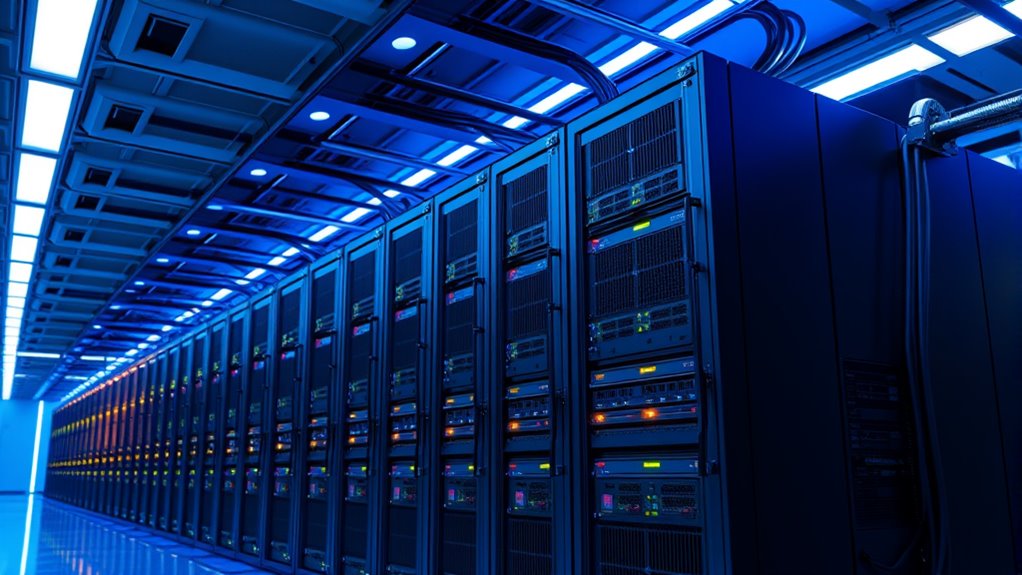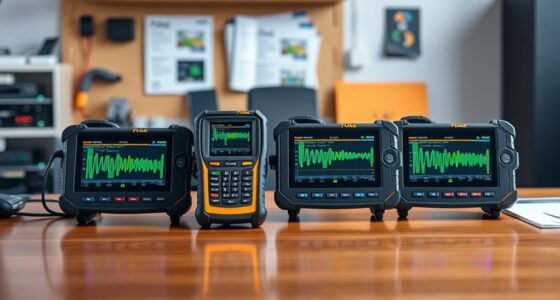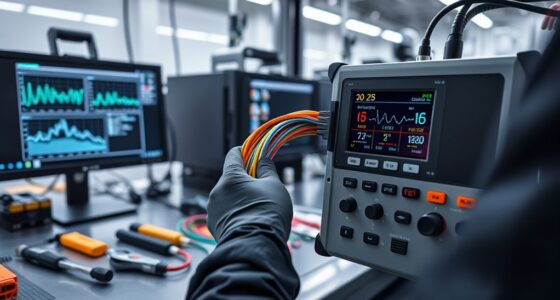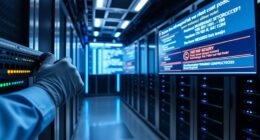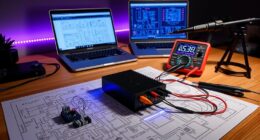When selecting enterprise core switches for data centers in 2025, I focus on high-speed performance, robust connectivity options, management features, and build quality to guarantee reliability and scalability. Switches like the Ubiquiti US-16-XG and Cisco C9500-16X-A offer blazing-fast throughput and advanced security. Port flexibility, energy efficiency, and redundancy are crucial, too. To find the best fit for your needs, you’ll want to explore detailed options, which we’ll uncover in the full overview.
Key Takeaways
- Prioritize switches with high non-blocking throughput (up to 1.6Tbps) to handle demanding data center traffic loads efficiently.
- Select models with multiple 10GbE, 25GbE, or higher uplink ports for scalable backbone connectivity.
- Opt for enterprise-grade management features like VLAN, QoS, SNMP, and advanced security protocols for reliable network control.
- Consider durable, rack-mountable designs with redundant power and cooling for maximum uptime.
- Ensure compatibility with fiber transceivers and multi-gigabit ports for future-proof high-speed device integration.
MokerLink 6 Port Managed Switch (10Gbps)
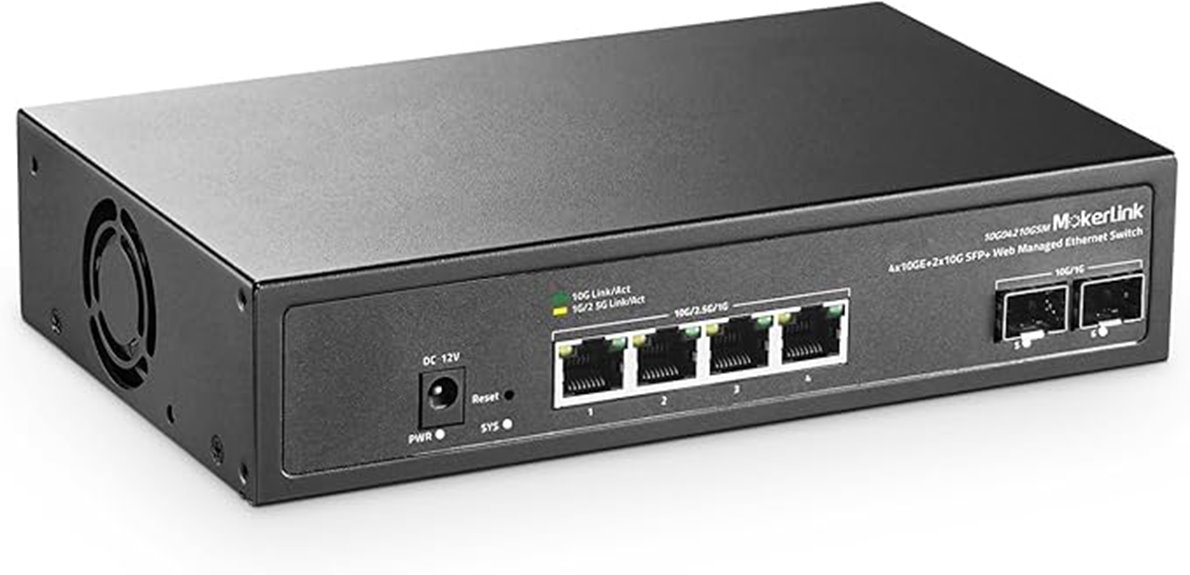
Looking for a reliable core switch that can handle high-speed data transfer in demanding data center environments? The MokerLink 6 Port Managed Switch (10Gbps) is a solid choice. It features four 10Gbps Ethernet ports that automatically adapt to various speeds and two additional 10Gbps SFP+ ports for extended fiber connections. With a switching capacity of 120Gbps, it supports non-blocking, line-rate forwarding across all ports. Its management features include QoS, VLAN, link aggregation, and SNMP, making it easy to control and optimize your network. Built with an industrial-grade metal case and efficient cooling, this switch is designed for durability and high performance in critical data center roles.
Best For: organizations and data centers requiring high-speed, reliable network switching with easy management and scalable fiber connectivity.
Pros:
- Supports non-blocking 10Gbps line-speed forwarding across all ports for optimal performance
- Includes 4x10Gbps Ethernet ports and 2x10Gbps SFP+ ports for versatile high-speed connections and extended fiber reach
- Industrial-grade construction with durable metal casing and efficient cooling for demanding environments
Cons:
- Default SFP modules are not included, requiring additional purchase for fiber connectivity
- Limited to 6 ports, which may not suffice for very large network deployments without additional switches
- Lacks encryption features, potentially raising security considerations in sensitive applications
NETGEAR 24-Port Gigabit Ethernet Unmanaged Switch

If you’re seeking a reliable, easy-to-deploy switch for small to medium-sized network environments, the NETGEAR 24-Port Gigabit Ethernet Unmanaged Switch is an excellent choice. It offers 24 gigabit ports, supporting high-speed data transfer without the need for complex configuration. Its plug-and-play setup makes installation straightforward, whether desktop or rackmount, with included hardware. The energy-efficient design complies with IEEE802.3az, reducing power consumption, and its silent operation suits noise-sensitive spaces. Backed by a lifetime limited warranty, next-business-day replacement, and 24/7 support, this switch combines simplicity, reliability, and performance for smaller networks.
Best For: small to medium-sized businesses and home networks seeking a reliable, easy-to-install unmanaged switch with high-speed connectivity.
Pros:
- Plug-and-play setup for quick and simple installation
- Energy-efficient design reduces power consumption and costs
- Silent operation ideal for noise-sensitive environments
Cons:
- Limited to unmanaged, plug-and-play functionality without advanced management features
- Designed for use in U.S. & Canada only, restricting international deployment
- No support for PoE (Power over Ethernet) features
4-Port 2.5G Switch with 2 x 10G SFP+, Vlan, for Home and Office

The 4-Port 2.5G Switch with 2 x 10G SFP+ ports is an ideal choice for home and office users seeking high-speed, reliable network connectivity. It supports adaptive speeds up to 2.5G and 10G, ensuring fast data transfer for demanding applications like 4K streaming, gaming, and NAS access. Its VLAN feature enhances security and bandwidth management, while plug-and-play installation makes setup simple. Encased in a durable, fanless metal housing, it operates silently and efficiently. Compatibility with various devices like WiFi6 APs, PCs, and servers makes it versatile for small offices, homes, and small business environments, delivering robust performance without complexity.
Best For: home and small office users seeking high-speed, reliable network connectivity with easy setup and security features.
Pros:
- Supports adaptive speeds up to 2.5G and 10G for fast data transfer
- Built-in VLAN for enhanced security and bandwidth management
- Plug-and-play, fanless design for silent operation and easy installation
Cons:
- Limited to 4 Ethernet ports, which may not suit larger networks
- No advanced management features for enterprise-level customization
- Requires compatible devices to fully utilize 2.5G and 10G speeds
QNAP 10-Port 10GbE Managed Switch (QSW-M2108R-2C-US)

The QNAP QSW-M2108R-2C-US stands out as an ideal choice for small to medium-sized enterprises seeking high-speed, space-efficient network upgrades. Its compact, half-width design fits easily into a 1U rack, supporting multiple speeds up to 10GbE and 5GbE over existing cabling. With 8 PoE+ ports and 2 combo 10GbE SFP+/RJ45 ports, it simplifies network expansion and device powering. The switch offers robust Layer 2 management via a user-friendly GUI, delivers high throughput, and maintains quiet operation. Reliable and well-built, it’s perfect for demanding environments where space, performance, and power over Ethernet are priorities.
Best For: small to medium-sized enterprises and advanced home networks seeking high-speed, space-efficient, and reliable network switching solutions with PoE capabilities.
Pros:
- Compact half-width design fits easily into 1U racks, saving space
- Supports multiple high-speed options up to 10GbE and 5GbE over existing cables
- PoE+ ports simplify powering network devices without additional equipment
Cons:
- Limited management features, such as minimal port statistics and lack of detailed diagnostics
- Out-of-the-box management interface does not support PoE on all models listed
- Higher cost compared to basic switches with fewer features
Ubiquiti Networks US-16-XG 10G 16-Port Managed Aggregation Switch (Renewed)

For data centers seeking a reliable, high-performance aggregation switch, the Ubiquiti Networks US-16-XG stands out with its 16 ports supporting 1G and 10G speeds. It offers non-blocking throughput of 160 Gbps and a switching capacity of 320 Gbps, ensuring smooth data flow. The switch is rack-mountable and connects easily to other US-16-XG units or core servers via 6 uplink ports and 4 Ethernet ports. As a renewed product, it’s professionally inspected and certified, delivering like-new performance at a lower cost. With a solid customer rating, it’s a compelling choice for expanding or upgrading data center networks.
Best For: small to medium-sized data centers and network administrators seeking a reliable, high-performance managed aggregation switch with 10G capabilities.
Pros:
- Supports non-blocking throughput of 160 Gbps and switching capacity of 320 Gbps for optimal data flow.
- Rack-mountable design with multiple uplink and Ethernet ports for flexible connectivity.
- Professionally inspected and certified as renewed, offering like-new performance at a lower cost.
Cons:
- Being a refurbished product, it may have a shorter remaining lifespan compared to new units.
- Limited to 16 ports, which may not suffice for very large network setups.
- No built-in Wi-Fi or wireless features, requiring additional devices for wireless connectivity.
Ubiquiti Networks US-16-XG 10G 16-Port Managed Aggregation Switch,White

Ubiquiti Networks US-16-XG stands out as an ideal choice for enterprise data centers that require high-bandwidth aggregation and reliable performance. With 16 ports supporting 10Gbps speeds—12 SFP+ for fiber and 4 RJ45 for copper—it delivers non-blocking throughput up to 160 Gbps and a switching capacity of 320 Gbps. Its robust build, rack-mountable design, and advanced Layer-2 features make it perfect for network backbone applications. The switch integrates seamlessly with the UniFi ecosystem, offers easy management via UniFi Controller, and supports high-performance uplinks. Overall, it’s a cost-effective, scalable solution for high-demand data center environments.
Best For: enterprises and data centers seeking high-performance, scalable 10Gbps network aggregation with reliable Layer-2 switching capabilities.
Pros:
- Supports non-blocking throughput up to 160 Gbps and a switching capacity of 320 Gbps for high-speed data transfer
- Seamless integration with UniFi Controller for easy management and network visualization
- Durable metal case with rack-mountable design suitable for enterprise environments
Cons:
- Potential compatibility issues with certain third-party DACs and SFP modules requiring careful hardware selection
- Ports do not auto-negotiate to 100Mbps, possibly needing manual configuration for some devices
- Some users have experienced device adoption errors or hardware resets, which may require troubleshooting or RMA procedures
YuanLey 28 Port Gigabit Managed Switch

Designed with high-performance demands in mind, the YuanLey 28 Port Gigabit Managed Switch is ideal for small to medium-sized networks that require reliable backbone connectivity. It features 24 Gigabit RJ45 ports and 4 10Gbps SFP+ slots, supporting a switching capacity of 128Gbps. Its flexible port configuration boosts scalability and performance, making it perfect for workgroups and servers. The switch offers advanced security with VLAN, ACL, and authentication protocols, along with robust management options like web interface, CLI, and SNMP. Additionally, its energy-efficient, fanless design guarantees silent operation and reduced power consumption, making it a cost-effective, reliable choice for growing networks.
Best For: small to medium-sized businesses and workgroups seeking reliable, high-capacity network backbone and advanced security features.
Pros:
- Supports high switching capacity of 128Gbps, ideal for demanding network environments.
- Offers flexible management options including web interface, CLI, and SNMP for easy configuration and monitoring.
- Energy-efficient and silent operation with a fanless design reduces power consumption and noise.
Cons:
- Limited to 24 Gigabit ports and 4 SFP+ slots, which may not meet very large network expansion needs.
- Advanced features might require technical expertise for optimal configuration.
- Compatibility with other brands may occasionally pose integration challenges in complex setups.
12 Port 10G SFP+ Managed Switch with IPv6, QoS, and Lifetime Support

If you’re managing a data center that demands high-speed, reliable connectivity, this 12-port 10G SFP+ managed switch is an ideal choice. It offers advanced features like IPv6, QoS, static routing, and L2/L3+ support, ensuring robust network performance. Its security controls include VLAN, ACL, DoS protection, and port security, safeguarding your infrastructure. The switch supports multi-mode and single-mode SFP modules, with management options via web, CLI, and SNMP. Built with durability and ease of use in mind, it includes lifetime support, storm control, loop detection, and remote monitoring, making it a versatile, future-proof solution for data centers.
Best For: organizations and data centers seeking high-speed, reliable, and secure network connectivity with advanced management and future-proof features.
Pros:
- Supports high-speed 10G SFP+ ports with flexible SFP module options for versatile connectivity.
- Comprehensive security features including VLAN, ACL, DoS protection, and port security to safeguard the network.
- User-friendly management via web interface, CLI, and SNMP, with lifetime support for ongoing reliability.
Cons:
- Requires SFP modules (not included), which may add to initial setup costs.
- Dimensions and weight may require adequate space and sturdy mounting options.
- Advanced features may necessitate technical expertise for optimal configuration and management.
HP JC772A Procurve Switch 5900Af-48Xg-4Qsfp+

Looking for a high-performance switch that can handle demanding server and storage traffic in large enterprise data centers? The HP JC772A Procurve Switch 5900Af-48Xg-4Qsfp+ is designed for that purpose. It supports virtualized applications, server-to-server traffic, Ethernet and storage traffic convergence, and ultra-low latency. Suitable for deployment at the server access layer or data center core in medium-sized enterprises, it delivers 1,280 Gbps data transfer rates via SFP+ ports. With 48 10GbE ports and four 40GbE QSFP+ uplinks, it offers scalability and reliable connectivity. HP’s proven technology guarantees robust performance for demanding enterprise environments.
Best For: large enterprise data centers and medium-sized enterprise core layers seeking high-performance, low-latency network switching solutions for server, virtualized, and storage traffic.
Pros:
- Supports ultra-low latency and high data transfer rates up to 1,280 Gbps.
- Offers extensive scalability with 48 10GbE ports and four 40GbE QSFP+ uplinks.
- Designed for demanding environments with virtualization, server-to-server, and storage traffic convergence.
Cons:
- Heavier and larger in size, weighing 30 pounds and measuring 18 x 2 x 26 inches.
- Requires 240-volt power supply, which may limit deployment options in some environments.
- Case material is plastic, potentially affecting durability in rugged settings.
NETGEAR SFP Transceiver (AGM731F) for Gigabit Fiber
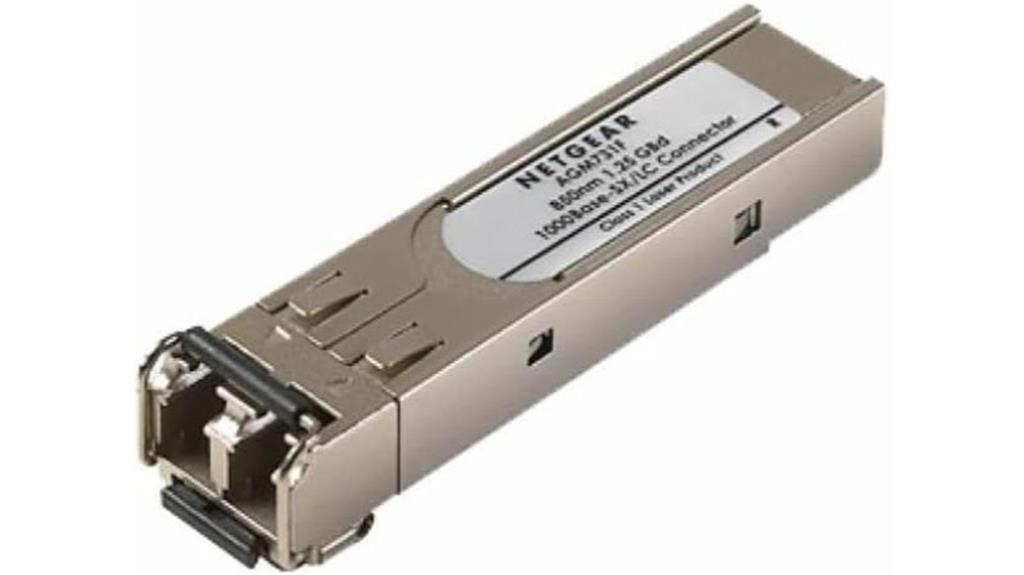
The NETGEAR AGM731F SFP transceiver stands out as an ideal choice for data centers requiring reliable gigabit fiber connections. It offers seamless compatibility with NETGEAR M4300 switches and other SFP GBIC slots, enabling plug-and-play installation with minimal downtime. Supporting 1000BASE-SX multimode fiber up to 550 meters, it ensures high-speed data transfer for bandwidth-intensive applications like video streaming, virtualization, and campus backbones. Designed for durability, it resists vibration and temperature fluctuations, maintaining signal integrity. Its compact, hot-swappable form factor simplifies upgrades and maintenance, while low power consumption helps reduce operational costs. Overall, it’s a dependable, easy-to-integrate solution for high-performance fiber connectivity.
Best For: organizations seeking reliable, high-speed gigabit fiber connectivity for data centers, enterprise networks, and bandwidth-intensive applications.
Pros:
- Seamless compatibility with NETGEAR M4300 switches and SFP GBIC slots for easy installation
- Supports up to 550 meters transmission over multimode fiber, ideal for extensive network setups
- Rugged design resists vibration and temperature fluctuations, ensuring signal integrity in various environments
Cons:
- Limited to multimode fiber applications within 550 meters, not suitable for longer distances
- Requires compatible SFP slots; not compatible with all network hardware out of the box
- May involve additional costs for installation and maintenance of fiber optic infrastructure
NETGEAR M4350-32F8V 40-Port 10G/25G Fiber Switch
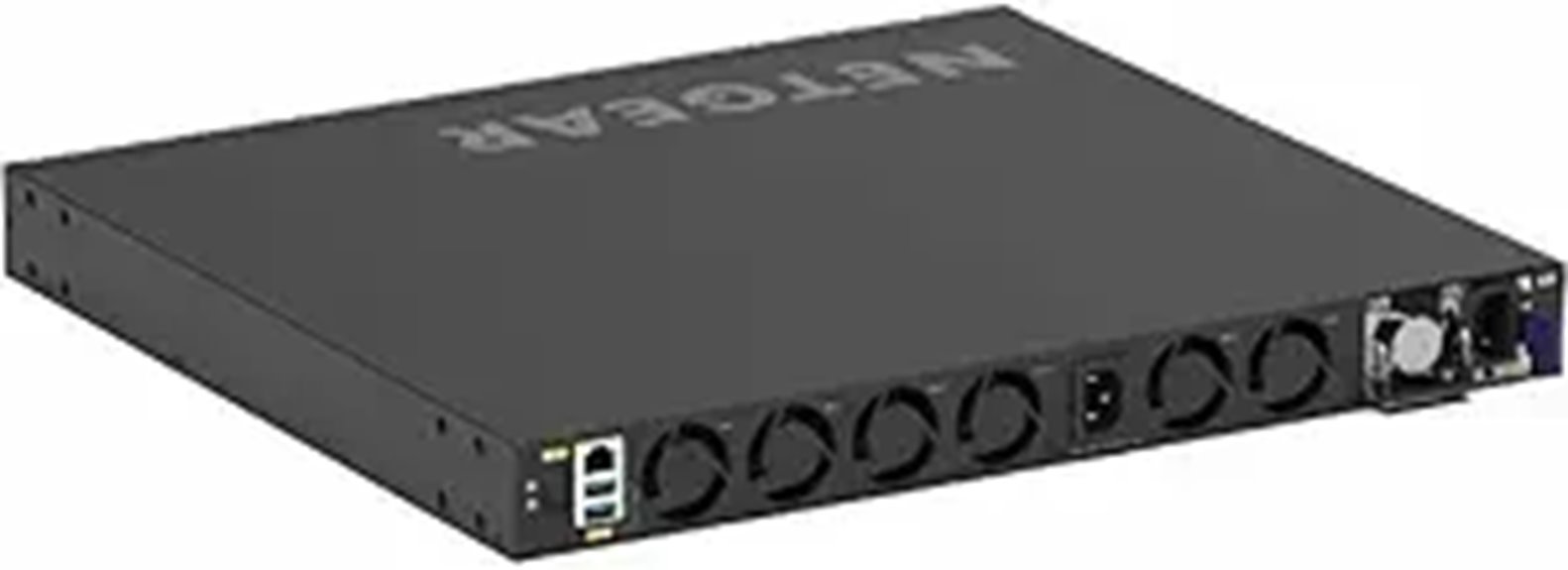
The NETGEAR M4350-32F8V switch is an ideal choice for data centers requiring high-capacity, low-latency fiber connectivity. It offers 40 ports—32x10G and 8x25G SFP+/SFP28—delivering over 1Tbps of non-blocking bandwidth, perfect for demanding enterprise environments. Its stackable 1U design supports seamless expansion and flexible deployment, while front-to-back airflow ensures superior cooling in dense racks. Advanced Layer 3 routing features, including OSPF and VRRP, optimize traffic management. Combined with enterprise-grade security and management options like CLI and cloud support, this switch provides a reliable, scalable foundation for modern data center networks.
Best For: large-scale data centers and enterprise networks requiring high-capacity, low-latency fiber connectivity with scalable and secure network infrastructure.
Pros:
- High non-blocking bandwidth of over 1Tbps supporting demanding traffic loads
- Stackable 1U design allows for flexible expansion and seamless deployment
- Advanced Layer 3 routing and enterprise-grade security features enhance network performance and protection
Cons:
- May require specialized knowledge for optimal configuration and management
- Higher initial investment compared to basic switches with fewer features
- Physical size and density may be excessive for smaller or less complex network environments
Linksys LGS328C 24-Port Managed Network Switch
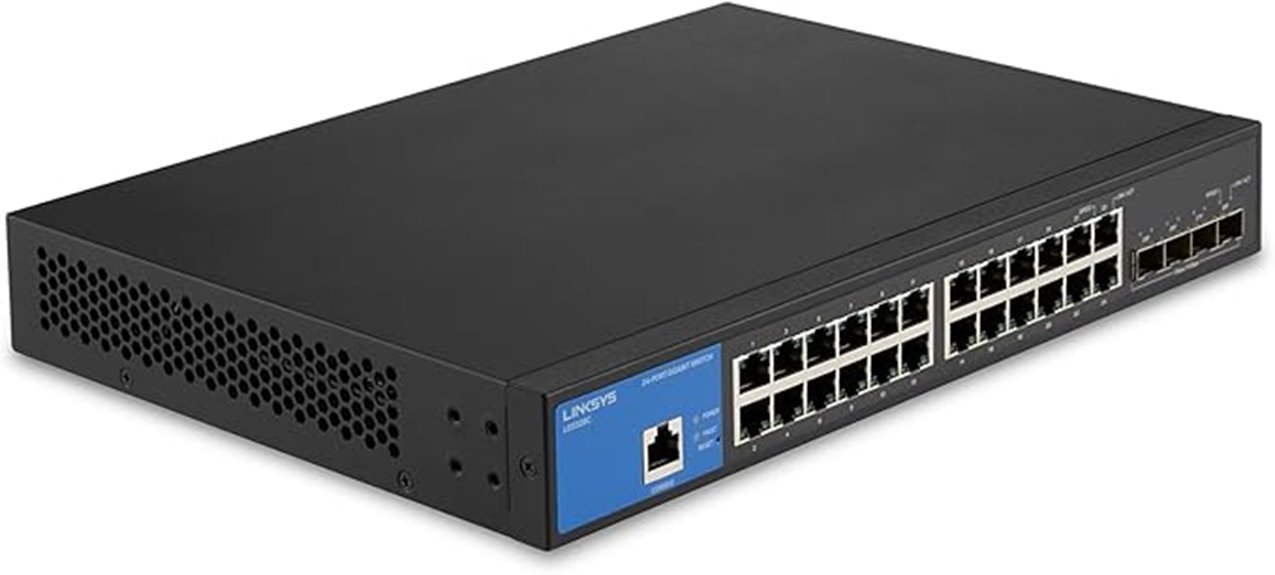
Are you seeking a reliable, feature-rich switch suitable for small to medium-sized enterprise networks or data centers? The Linksys LGS328C is a 24-port Gigabit managed switch with four 10G SFP+ uplink ports, perfect for high-bandwidth needs. Its metal housing supports desktop and wall mounting, offering flexible deployment options. With a user-friendly web management console, it simplifies configuration of VLANs, QoS, and security features like port authentication and DHCP snooping. Delivering a total data transfer rate of 128 Gbps, it ensures quick, stable connections. Its quiet operation and compact design make it ideal for diverse environments, providing future-proof expansion without sacrificing performance.
Best For: small to medium-sized enterprises or data centers seeking a reliable, high-performance managed switch with advanced security and expansion capabilities.
Pros:
- Supports 24 Gigabit Ethernet ports with four 10G SFP+ uplinks for high bandwidth and scalability
- Features a user-friendly web-based management console for easy configuration of VLANs, QoS, and security settings
- Durable metal housing with desktop and wall-mount options, ensuring flexible deployment and quiet operation
Cons:
- Higher price point compared to some competitors like TP-Link
- Initial setup may require troubleshooting for IP assignment or VLAN configuration
- Limited to 24 ports, which may not suffice for very large network environments
Cisco C9500-16X-A Catalyst 9500 16-Port 10Gig Switch w/ Dual PSU (Renewed)

Looking for a high-performance switch that guarantees maximum uptime in your data center? The Cisco C9500-16X-A Catalyst 9500 offers 16 10G SFP+ ports, supporting up to 480 Gbps of switching capacity. It’s designed for enterprise core or aggregation layers, delivering fast, reliable data transfer. The switch features dual hot-swappable power supplies and built-in redundant fans, ensuring continuous operation and easy maintenance. With advanced security options like MACsec encryption and Cisco TrustSec, plus programmable automation via IOS XE, it combines security with flexibility. This renewed model provides enterprise-grade performance and resilience, making it an excellent choice for demanding data center environments.
Best For: enterprise IT teams seeking a high-performance, reliable switch for core or aggregation layers in data centers or campus networks.
Pros:
- Supports up to 480 Gbps switching capacity for high-speed data transfer
- Equipped with dual hot-swappable power supplies and redundant fans for maximum uptime
- Offers advanced security features like MACsec encryption and Cisco TrustSec
Cons:
- Renewed model may have limited warranty coverage compared to new devices
- Requires technical expertise for setup and management of advanced features
- May be overkill for smaller or less demanding network environments
NETGEAR MSM4328F 36 Port 10G Switch
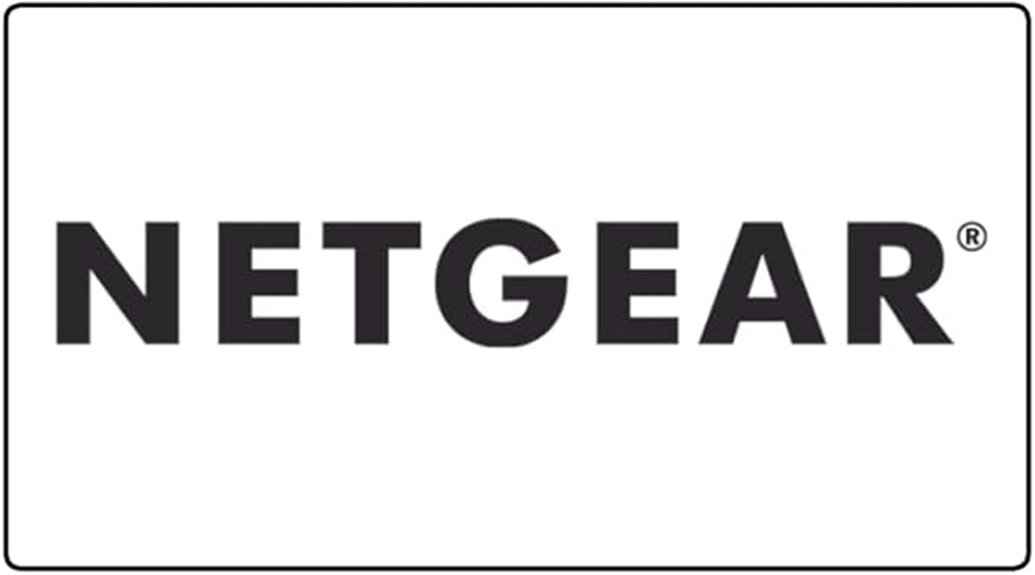
For data centers seeking high-speed, scalable networking solutions, the NETGEAR MSM4328F 36 Port 10G Switch stands out as an ideal choice. It offers 36 ports, including 24 SFP slots supporting 1G/2.5G speeds and 4 combo 10GBASE-T/SFP+ uplinks, delivering a robust 320Gbps fabric. Its stackable 1U rack-mount design ensures easy integration and cable management. Powered by an ARM Cortex A57 CPU and 4GB RAM, it guarantees reliable, wire-speed performance. With advanced Layer 3 management, security features, and cloud support, this switch provides a flexible, future-proof solution for demanding enterprise networks and data center environments.
Best For: large data centers and enterprise networks seeking high-speed, scalable, and secure networking solutions with advanced management capabilities.
Pros:
- Supports high-density 36-port configuration with 24 SFP slots and 4 uplink ports for flexible scalability.
- Features robust Layer 3 management, security, and QoS options suitable for complex network environments.
- Stackable design with hot-swappable ports allows for easy expansion and minimal downtime.
Cons:
- May be overkill for smaller networks or organizations with less demanding bandwidth needs.
- Higher cost compared to unmanaged or less advanced switches, which could be a barrier for some budgets.
- Requires knowledgeable management for optimal configuration and security setup, potentially increasing deployment time.
NETGEAR M4350-16V4C 20-Port Managed Switch

The NETGEAR M4350-16V4C 20-Port Managed Switch stands out as an ideal choice for enterprise data centers requiring high-performance backbone connectivity. Its 1.6Tbps throughput guarantees ultra-fast data transfer, supporting demanding applications like IPTV streaming and large-scale virtualization. With 16×1/10/25G SFP28 ports and 4×40/100G QSFP28 ports, it offers scalable bandwidth with low latency and zero bottlenecks. Advanced Layer 3 features like OSPF, RIP, and VRRP enable seamless routing and multicast optimization. The switch’s stackable, rack-mount design simplifies management, while security tools like RADIUS and SSH safeguard critical data assets, making it a robust core switch solution.
Best For: enterprises and data centers seeking a high-performance, scalable, and secure core switch to support demanding applications and complex network environments.
Pros:
- Ultra-high throughput of 1.6Tbps ensures fast, reliable data transfer for bandwidth-intensive tasks.
- Supports advanced Layer 3 routing protocols like OSPF, RIP, and VRRP for seamless network management.
- Stackable design and flexible port options facilitate easy scalability and simplified cable management.
Cons:
- May be cost-prohibitive for small organizations or limited budgets.
- Complexity of features might require specialized knowledge for optimal configuration and management.
- Larger physical footprint could be a consideration for space-constrained environments.
Factors to Consider When Choosing an Enterprise Core Switch for Data Centers

When selecting an enterprise core switch for a data center, I focus on key factors like port capacity and speed to guarantee it can handle current and future traffic. I also consider scalability and management features to support growth and simplify configuration. Additionally, security, reliability, and uptime are vital to keep the network secure and operational at all times.
Port Capacity and Speed
Ever wondered how the port capacity and speed of an enterprise core switch impact your data center’s performance? The number of ports determines how many devices you can connect simultaneously, directly affecting scalability. Higher port speeds like 10Gbps or 25Gbps enable faster data transfers, which are essential for maintaining high performance. Uplink ports with 40Gbps or 100Gbps capacity provide the bandwidth needed for backbone connections and data aggregation, preventing bottlenecks. Additionally, switches supporting multi-gigabit speeds, such as 2.5G or 5G, allow seamless integration of newer high-speed devices. Striking the right balance between port capacity and speed ensures your network remains efficient, minimizes congestion, and supports future growth in your data center environment.
Scalability and Expansion
Choosing an enterprise core switch that supports scalability and expansion is vital for future-proofing your data center. I look for high port density—48 ports or more—to handle future growth without immediate upgrades. Flexible uplink options, like multiple 10G, 25G, or 40G ports, are essential for seamless expansion of high-speed connections. Support for stacking or chassis-based architectures allows me to add or upgrade modules easily, minimizing network downtime. Compatibility with advanced routing and VLAN features ensures the switch can manage increased traffic loads efficiently as demands grow. Additionally, a high throughput capacity—around 400 Gbps or more—along with support for multiple high-speed uplinks, guarantees the switch can handle future data demands without bottlenecks. Scalability is truly a key factor in making a future-proof choice.
Management and Configuration
How do you guarantee your data center network remains flexible and secure? It starts with choosing a managed enterprise core switch that offers robust management and configuration options. These switches support advanced protocols like SNMP, CLI, and web interfaces, giving you thorough control over your network. Features like VLAN segmentation, QoS prioritization, and link aggregation help optimize traffic flow and performance. You can implement static and dynamic routing, ACLs, and spanning tree protocols to maintain stability and security. Remote management tools enable efficient troubleshooting and adjustments without physical access. Additionally, features like port mirroring, device authentication, and redundancy configurations boost reliability and security. These capabilities ensure your network is adaptable, well-controlled, and resilient against issues.
Security Features
Security features are a key consideration when selecting an enterprise core switch for data centers, as they help protect the network from threats and unauthorized access. I look for switches supporting advanced protocols like 802.1X, RADIUS, and TACACS+ to guarantee robust user authentication and device control. Essential features such as ACLs, port security, and IP-MAC binding are crucial for filtering traffic and preventing unauthorized connections. Support for DoS attack prevention, storm control, and intrusion detection further enhances security against malicious threats and network disruptions. Layer 2 and Layer 3 security capabilities, including VLAN segmentation and access control policies, help isolate sensitive data and contain lateral movement. Regular firmware updates and hardware encryption support, like MACsec, are fundamental for maintaining security and addressing emerging vulnerabilities.
Reliability and Uptime
Ensuring high reliability and maximum uptime is vital when selecting an enterprise core switch for data centers. I look for switches with redundant power supplies and fans, which keep operations continuous and reduce downtime. High switching capacity and a non-blocking architecture are critical for handling peak traffic without interruptions. Robust hardware with built-in fault detection and auto-recovery features further enhance network reliability. Features like hot-swappable modules and failover capabilities allow seamless maintenance without service disruption. Additionally, I emphasize the importance of regular firmware updates and security patches to prevent vulnerabilities that could cause outages. These factors collectively guarantee the network remains resilient, available, and capable of supporting the demanding needs of modern data centers.
Compatibility and Integration
When selecting an enterprise core switch for a data center, it’s crucial to verify that it supports standard network protocols like SNMP, VLAN, and LACP to guarantee smooth integration with your existing infrastructure. Compatibility with both fiber and copper transceivers, such as SFP, SFP+, or QSFP modules, provides the flexibility needed for diverse connectivity needs. Ensuring the switch can interface effectively with your network management systems and supports open standards simplifies management and future upgrades. Additionally, choose a switch that aligns with your physical architecture, including rack-mount options and appropriate port densities. Finally, confirm it can interoperate seamlessly with other devices and switches within your data center, enabling scalable, consistent network performance and minimizing integration issues down the line.
Cost and Total Value
Evaluating the cost and overall value of an enterprise core switch requires looking beyond the initial purchase price to include ongoing expenses like maintenance, support, and future upgrades. A higher upfront investment in a feature-rich switch can deliver better long-term value through enhanced performance, scalability, and fewer hardware additions down the line. To determine cost-effectiveness, compare the switch’s capacity, port count, and management features relative to its price. Total value also involves factoring in warranty support, firmware updates, and compatibility with your existing infrastructure, ensuring you maximize return on investment. Investing in a switch with advanced security, redundancy, and scalability features can prevent costly outages and reduce future upgrade expenses, offering a more strategic and economical choice for your data center.
Frequently Asked Questions
How Do Enterprise Switches Prioritize Traffic for Critical Applications?
Enterprise switches prioritize traffic for critical applications through Quality of Service (QoS) settings. I configure QoS policies to assign higher priority to essential data, ensuring it gets through faster during congestion. By tagging important traffic and setting appropriate queues, I make sure crucial applications like VoIP or databases receive the bandwidth they need. This way, critical operations stay smooth, even when network demand peaks.
What Are the Energy Efficiency Considerations for Core Switches?
Did you know that data centers account for about 1% of global electricity use? When choosing core switches, energy efficiency is vital. I look for models with low power consumption, advanced cooling features, and support for energy-saving protocols like IEEE 802.3az. Prioritizing these factors not only reduces operational costs but also helps minimize environmental impact. It’s an essential aspect in building sustainable, cost-effective data center infrastructure.
How Scalable Are These Switches for Future Data Center Expansion?
These switches are highly scalable, allowing me to expand my data center easily as my needs grow. I look for models that support stacking, modular designs, and high port densities, which enable me to add more capacity without replacing existing hardware. Future-proof switches also offer flexible uplink options and software-defined networking features, ensuring I can adapt smoothly to evolving technology demands without major disruptions or costly upgrades.
What Is the Typical Lifespan and Warranty Coverage for Enterprise Core Switches?
Enterprise core switches typically last around 5 to 7 years, depending on usage and technological advancements. I recommend checking the manufacturer’s warranty, which often covers 3 to 5 years for hardware defects and support. Regular firmware updates can prolong their lifespan. When buying, I always look for switches with solid warranty coverage to ensure reliable performance and peace of mind over the years.
How Do Switches Handle Security Features Like Access Control and Threat Mitigation?
Switches handle security by integrating access control and threat mitigation directly into their hardware and software. I find that features like 802.1X authentication, ACLs, and port security keep unauthorized users out, while advanced threat detection helps identify anomalies early. This layered approach acts like a fortress, safeguarding data without slowing network performance. In essence, robust security features are crucial for protecting sensitive information in today’s data-driven world.
Conclusion
Choosing the right enterprise core switch can greatly boost your data center’s efficiency. Did you know that businesses upgrading to high-speed switches see an average 30% increase in network performance? By considering key factors like port speed, scalability, and management features, you can find a switch that meets your needs now and grows with you. Investing wisely ensures smoother operations and future-proofing your infrastructure for years to come.
